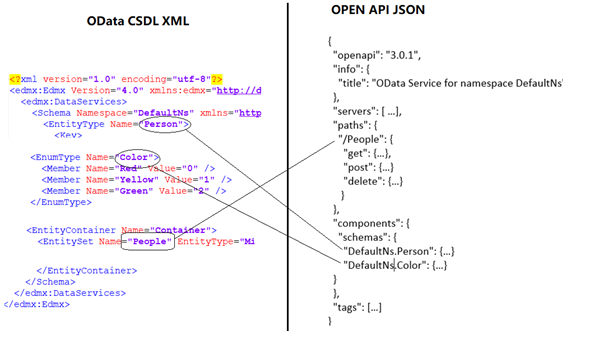* Disambiguate put and patch operation ids * Update tests * Updates release note |
||
|---|---|---|
| .azure-pipelines | ||
| .github | ||
| .vscode | ||
| docs | ||
| scripts | ||
| src | ||
| test/Microsoft.OpenAPI.OData.Reader.Tests | ||
| tool | ||
| .editorconfig | ||
| .gitignore | ||
| Build.props | ||
| CODE_OF_CONDUCT.md | ||
| LICENSE | ||
| Microsoft.OpenApi.OData.sln | ||
| README.md | ||
| SECURITY.md | ||
| build.cmd | ||
| build.ps1 | ||
| build.root | ||
README.md
Convert OData to OpenAPI.NET
Introduction
The Microsoft.OpenAPI.OData.Reader library helps represent an OData service metadata as an OpenApi description. It converts OData CSDL, the XML representation of the Entity Data Model (EDM) describing an OData service into Open API based on OpenAPI.NET object model.
The conversion is based on the mapping doc from OASIS OData OpenAPI v1.0 and uses the following :
- Capabilities vocabulary annotation
- Authorization vocabulary annotation
- Core vocabulary annotation
- Navigation property path
- Edm operation and operation import path
Overview
The image below is generic overview of how this library can convert the EDM model to an OpenAPI.NET document object.
For more information on the CSDL and Entity Data model, please refer to http://www.odata.org/documentation. For more information about the Open API object of model, please refer to http://github.com/microsoft/OpenAPI.NET
Sample code
The following sample code illustrates the use of the library
public static void GenerateOpenApiDescription()
{
IEdmModel model = GetEdmModel();
OpenApiDocument document = model.ConvertToOpenApi();
var outputJSON = document.SerializeAsJson(OpenApiSpecVersion.OpenApi3_0);
var outputYAML = document.SerializeAsYaml(OpenApiSpecVersion.OpenApi3_0);
}
public static IEdmModel GetEdmModel()
{
// load EDM model here...
}
Or with the convert settings:
public static void GenerateOpenApiDescription()
{
IEdmModel model = GetEdmModel();
OpenApiConvertSettings settings = new OpenApiConvertSettings
{
// configuration
};
OpenApiDocument document = model.ConvertToOpenApi(settings);
var outputJSON = document.SerializeAsJson(OpenApiSpecVersion.OpenApi3_0);
var outputYAML = document.SerializeAsYaml(OpenApiSpecVersion.OpenApi3_0);
}
public static IEdmModel GetEdmModel()
{
// load EDM model here...
}
The GetEdmModel() method can load a model in 3 ways:
-
Create the Edm model from scratch. For details refer building a basic model
-
Load the Edm model from CSDL file. The following shows a code sample that loads a model from a csdl file.
public static IEdmModel GetEdmModel() { string csdlFilePath = @"c:\csdl.xml"; string csdl = System.IO.File.ReadAllText(csdlFilePath); IEdmModel model = CsdlReader.Parse(XElement.Parse(csdl).CreateReader()); return model; } -
Create the Edm model using Web API OData model builder. For details refer to the web api model builder article
Nuget packages
The OpenAPI.OData.reader nuget package is at: https://www.nuget.org/packages/Microsoft.OpenApi.OData/
Contributing
This project welcomes contributions and suggestions. Most contributions require you to agree to a Contributor License Agreement (CLA) declaring that you have the right to, and actually do, grant us the rights to use your contribution. For details, visit https://cla.microsoft.com.
When you submit a pull request, a CLA-bot will automatically determine whether you need to provide a CLA and decorate the PR appropriately (e.g., label, comment). Simply follow the instructions provided by the bot. You will only need to do this once across all repos using our CLA.
You can also open an issue directly on this repo via this link.
This project has adopted the Microsoft Open Source Code of Conduct. For more information see the Code of Conduct FAQ or contact opencode@microsoft.com with any additional questions or comments.

